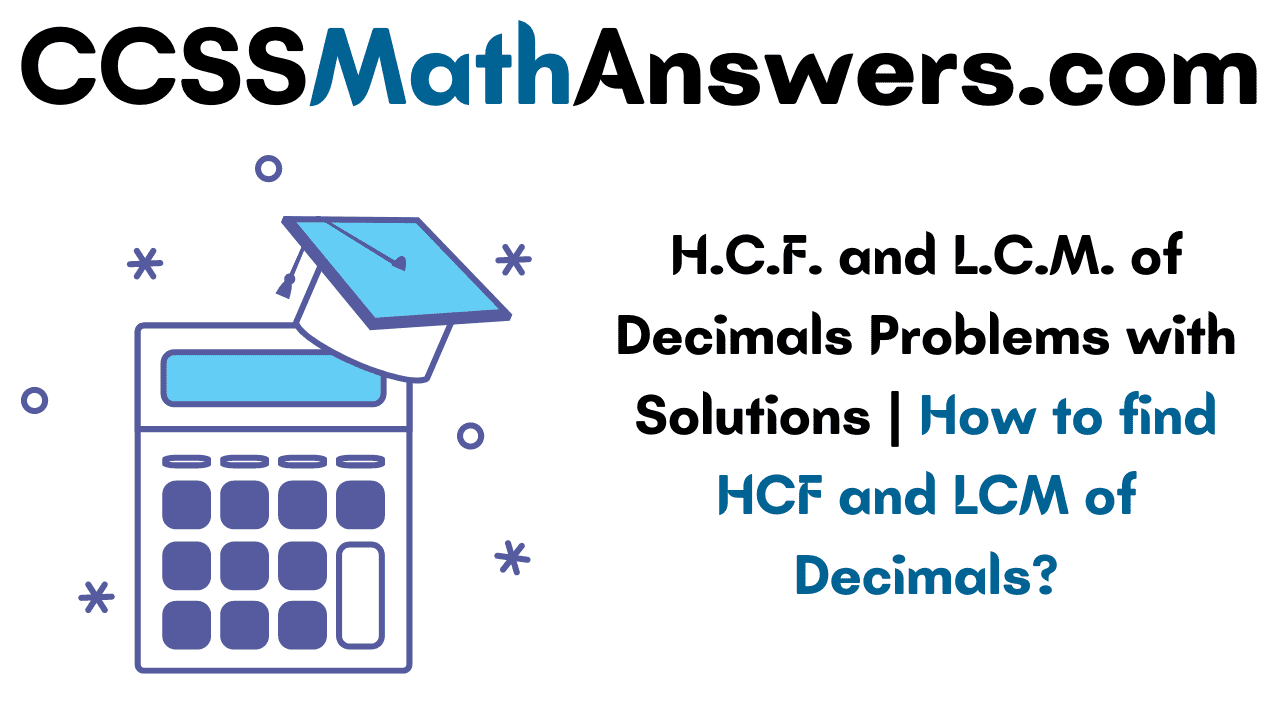Are you worried about how to calculate the Highest Common Factor and Least Common Multiple of Decimals? If so, don’t panic as we will give you the entire information on LCM, HCF Definitions, How to Calculate LCM and HCF of Decimals, etc. Solved Problems on HCF and LCM of Decimals explained in the later modules will help you to understand the concepts better.
Also, Read: Worksheet on LCM
Least Common Multiple & Highest Common Factor – Definitions
Highest Common Factor: Greatest Common Divisor or Highest Common Factor for two or more positive integers is the largest positive integer that divides the numbers exactly and leaves a remainder zero.
Least Common Multiple: Least Common Multiple or LCM of two or more numbers is the smallest or least positive integer that is divisible by both the numbers.
How to find HCF and LCM of Decimals?
While solving the Problems related to Highest Common Factor and Least Common Multiple follow the simple steps listed below. They are in the following fashion
- Firstly, convert unlike decimals to like decimals.
- Later, find the Least Common Multiple and Highest Common Factor using the regular procedure as if there is no decimal point.
- Once you obtain the HCF, LCM places the decimal point in the result as the same number of decimal places in the like decimals.
Worked Out Examples on HCF and LCM of Decimal Numbers
Example 1.
Find the HCF and LCM of 1.20 and 3.6?
Solution:
Given Decimals are 1.20 and 3.6
Since they are unlike decimals firstly convert them to like decimals by annexing them with the required number of zeros. The maximum number of decimal places is 2 and converting to like decimals we get
1.20 → 1.20
3.6 → 3.60
Now, find the LCM, HCF of Numbers without considering the decimal point as if they are regular numbers.
LCM(120, 360) = 360
HCF(120, 360) = 120
Now that you found the Least Common Multiple and Highest Common Factor place the decimal point the same number of places in the like decimals.
Thus, LCM of Decimals 1.20 and 3.60 is 3.60
HCF of Decimals 1.20 and 3.60 is 1.20
Therefore, LCM, HCF of Decimals 1.20 and 3.60 are 3.60, 1.20 respectively.
Example 2.
Find the H.C.F. and the L.C.M. of 0.24, 0.48, and 0.72?
Solution:
Given Decimals are 0.24, 0.48, 0.72
Since they are all like decimals we need not convert them again.
Find the LCM, HCF of given decimals considering them as regular numbers, and neglect the decimal point.
LCM(24, 48, 72) = 144
HCF(24,48,72) = 24
Since you found the Least Common Multiple and Greatest Common Factor place the decimal point the same number of places equal to the like decimals
Thus LCM of 0.24, 0.48, 0.72 is 1.44
HCF of 0.24, 0.48, 0.72 is 0.24
Thus, LCM and HCF of 0.24, 0.48, 0.72 are 1.44 and 0.24
Example 3.
Find the LCM, HCF of 0.5, 1.5, 0.27, and 3.6?
Solution:
Given Decimals are 0.5, 1.5, 0.27 and 3.6
Convert the given decimals to like decimals by simply placing the required number of zeros. The maximum number of decimal places is 2 so we will annex with the required zeros.
0.5 → 0.50
1.5 → 1.50
0.27 → 0.27
3.6 → 3.60
Find the LCM, GCF without considering the decimal point as if they are regular numbers.
LCM(50, 150, 27, 360) = 5400
HCF(50, 150, 27, 360) = 1
Now, place the decimal point in the result obtained the same number of decimal places as in the like decimals
LCM(0.5, 1.5, 0.27, 3.6) = 54.00
HCF(0.5, 1.5, 0.27, 3.6) = 0.01
Therefore, LCM and HCF of Decimals 0.5, 1.5, 0.27 and 3.6 are 54.00 and 0.01 respectively.
